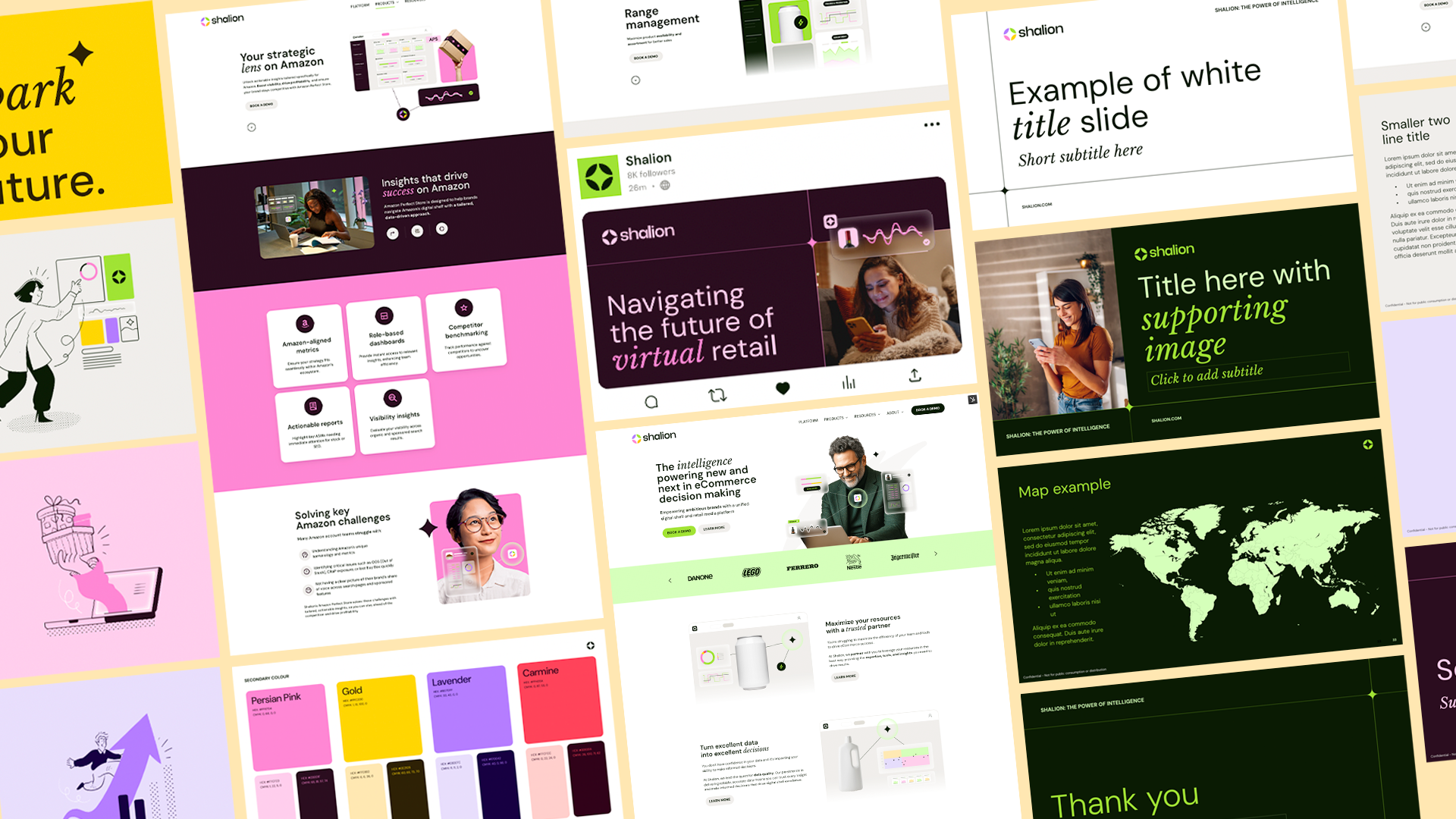Retail vs. commerce media: Where brands win (or lose) sales
You’re scrolling through TikTok when an influencer raves about a new shampoo for dry hair. The video is quick, engaging, and the “Buy Now” button is right there. You tap it, land on the brand’s website, and before you know it, you’ve made a purchase.
Or maybe not. Maybe you check reviews first, compare prices on Amazon, and end up buying from Target instead.
This is the new reality of shopping—fluid, fragmented, and shaped by multiple touchpoints. Social media-driven commerce is exploding, with platforms like TikTok Shop, Instagram Checkout, and Walmart’s DSP reshaping how consumers discover and buy products. Yet despite this shift, retailer websites accounted for 85.5% of sales in 2023 and will remain north of 80% for the next few years (81.3% in 2027).
For brands, the challenge isn’t choosing between retail media and commerce media—it’s finding a way to make them work together.
Retail media vs. commerce media: What’s the difference?
Retail media refers to advertising within retailer ecosystems—sponsored placements, search ads, and display campaigns on platforms like Amazon, Walmart, and Tesco. It ensures visibility where shoppers complete their purchases.
Commerce media is broader, covering digital ad placements beyond retailer sites—such as TikTok, Meta, Google Shopping, and YouTube ads—that drive awareness and engagement.
Both are crucial, but navigating this ecosystem is expensive—especially for smaller brands.
The cost of competing in retail & commerce media
For emerging brands, the cost of entry into this landscape is steep. Amazon Sponsored Ads, Walmart Connect, and Instacart Ads operate on auction-based models, meaning bigger budgets dominate search results. Meanwhile, paid placements on TikTok Shop or Meta can drive traffic, but conversion rates depend on whether the product is available at the right retailer at the right price.
For example:
- A skincare brand running TikTok ads might get thousands of clicks, but if they’re not monitoring stock levels at key retailers, they risk directing shoppers to an out-of-stock page.
- A large CPG brand like Unilever or P&G might invest millions in Amazon Sponsored Ads, but without real-time competitive tracking, they could overspend on bids for high-traffic keywords while a competitor undercuts their price.
How to bridge the gap
With shopping journeys becoming more fragmented, a digital shelf provider such as Shalion helps brands:
- Monitor media spend effectiveness – Is your sponsored product ad on Amazon actually driving conversions, or is the product out of stock or poorly ranked?
- Stay competitive in retail media auctions – Are competitors increasing bids on category terms, making sponsored placements more expensive?
- Ensure product availability and compliance – Are retailers running the right promotions? Is product content optimized across key platforms?
Winning in a fragmented shopping landscape
To compete effectively, brands need an integrated strategy that aligns retail and commerce media:
- Use commerce media (TikTok, Meta, Google) for discovery and engagement.
- Leverage retail media (Amazon, Walmart, Target) for conversions.
- Work with a digital shelf provider to track retail media performance, optimize on-site spend, and ensure seamless execution across key retailer channels.
Retail media is booming—here’s where to watch
While everyone’s talking about TikTok hauls and influencer shoutouts, the real money? It's still pouring into on-site retail media, where purchase intent is highest and first-party data reigns supreme.
Who’s leading the pack?
Amazon is still the king—owning more than 76% of the U.S. retail media pie, according to eMarketer. If you’re not optimizing your ad strategy for their algorithm, you're probably losing share.
Walmart Connect is stepping up fast, blending search ads, in-store placements, and even connected TV spots. Think: a shopper sees a snack ad on Hulu and adds it to their cart during a grocery run. Yes, that’s happening.
Instacart is turning delivery data into gold, helping brands like Häagen-Dazs test local promos by zip code—frozen treat, targeted reach.
In the UK, Tesco Media & Insight is tapping into Clubcard data to help CPG brands personalize offers down to the household level. Imagine serving different ads to pet owners vs. young families—on the same product page.
Carrefour Links and REWE are also gaining ground across France and Germany, turning their massive store networks into data-rich digital ad platforms.
The hotspots:
US: Retail media ad spend is on track to hit $129.93 billion by 2028, with brands shifting budgets from social to on-site channels for better ROI and measurability.
UK: Leading Europe’s charge, ad spend crossed $4 billion in 2024, with brands prioritizing Tesco, Asda, and Sainsbury’s networks.
France & Germany: Rapid investment in native retailer networks shows that retail media isn’t just a UK/US game.
Global hotspots: Where social commerce is heating up
When planning commerce media investments, it’s smart to analyze which markets already exhibit the consumer behavior you want to drive. Markets like China can offer inspiration, while fast-growing regions like India and Brazil offer first-mover advantages.
China – The global leader:
Why it matters: China is far ahead, thanks to platforms like WeChat, Douyin (TikTok’s sister app), and Xiaohongshu, which have seamlessly integrated content, commerce, and payment.
- What brands can learn: High conversion from livestreams, native shopping in feeds, and creator-led sales are the norm here.
South Korea – Livestreaming powerhouse:
Why it matters: South Korea has strong mobile-first infrastructure, high trust in influencers, and widespread use of live shopping.
- What brands can learn: Experiment with formats like QVC-style livestreams and creator-led flash deals.
India – Rapid adoption, mobile-first:
Why it matters: India has seen explosive growth in short-form video commerce (via apps like Moj and Meesho), especially in Tier 2 and 3 cities.
- What brands can learn: Mobile, regional language content + influencer partnerships drive discovery and conversion.
Brazil – Fast-growing social commerce market:
Why it matters: High social media usage and influencer culture make Brazil a strong testbed for Instagram and WhatsApp-based selling.
- What brands can learn: Focus on creator collaborations, chat-based selling, and local payment integration.
By being the first to enter a new market, brands can adopt a new technology, or tap into an emerging consumer trend—before its competitors do.
Discovery happens on social—but conversion?
A recent eMarketer report states that US retail social commerce sales will pass the $100 billion milestone in 2025, representing a 22.4% growth from the year prior.
Still…
Almost 4 in 10 shoppers hold back from shopping on social media over concerns about how platforms manage personal data, per a May 2023 PYMNTS.com survey.
While younger generations—especially Gen Z and Millennials—are highly engaged on platforms like TikTok and Instagram for product discovery, most still prefer to complete their purchases on traditional retailer websites. Social platforms are incredibly influential in shaping trends and generating interest, but when it comes time to hit “buy,” many consumers still trust the familiarity, convenience, and perceived security of established eCommerce sites like Amazon, Walmart, or brand-owned stores. That said, this gap is closing fast, as social commerce tools become more seamless and platforms continue to invest in native shopping experiences.
So what now?
Retail and commerce media aren’t competing forces—they’re two sides of the same strategy. Social platforms drive discovery, but retail websites remain the ultimate conversion point. For brands—big or small—the key to success isn’t just increasing ad spend, but making sure every dollar works harder.
In a market where competition is fierce and media costs are rising, the brands that win will be the ones that master the digital shelf.
Like to see how Shalion can help you optimize your digital shelf & media campaigns? Book a demo.
You May Also Like
These Related Stories

Why should my digital shelf provider care about retail media?

Advancing eCommerce intelligence: Shalion announces rebrand
